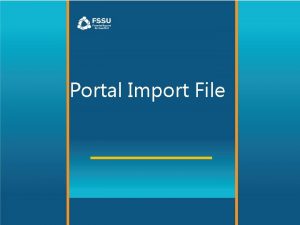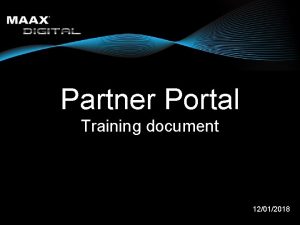INSERVICE TRAINING PORTAL 2020 InService Training History The



























- Slides: 27

IN-SERVICE TRAINING PORTAL 2020

In-Service Training History ■ The “F-2100” is the annual in-service training compliance report. The Commission has mandated annual in-service training since 2006 for deputies, and since 2007 for detention officers and telecommunicators. ■ Each agency that employs justice officers is required to submit the annual report to the Division by January 15 th of the following year. ■ Annual in-service training topics are chosen by the Joint In-service Training Committee which consists of sheriffs, chiefs, law enforcement agency representatives, as well as Justice Academy, Criminal Justice Standards, and Sheriffs’ Standards staff. ■ The Justice Academy develops lesson plans for each course topic that is selected by the Committee. ■ Annual in-service training must be completed by December 31 st of each year.

The F-2100 Report ■ The report includes all deputy sheriffs, detention officers, and telecommunicators who are (or were at some point in 2020) sworn or appointed with your agency and who have been reported to the Commission. If you find that any of your officers are missing from this report, please list them on this on-line report and ensure their certification packets have been submitted to the Division. ■ Please note that undercover officers are not included on this report. However, your agency must ensure that they, too, are in compliance with the mandated in-service training requirements.

COMPLETE THE ENTIRE FORM ■ Fill in data for each column that is applicable for each officer. Officers who serve in an ACTIVE status in more than one position with your agency must complete the mandated 2020 in-service training only for the position which has been designated as “primary” for that officer by your Sheriff. For these officers, please indicate their PRIMARY position in the “Reason” column to the right of the officer’s status. An officer’s failure to complete in-service training for his or her non-primary position will not result in a suspension. ■ INCOMPLETE FORMS CANNOT BE SUBMITTED THROUGH THE PORTAL AND WILL NOT BE ACCEPTED

DEPUTIES ■ The in-service training requirement for deputies in 2020 is 24 credits of mandatory training in the following topical areas: – – – – 2020 Firearms Training and Qualification 2020 Legal Update 2020 Long-Term Effects of Childhood Adversity 2020 The Signs Within: Suicide Prevention Education and Awareness 2020 Career Survival: Training and Standards Issues 2020 Communication Strategies When Encountering Persons Who are Deaf or Hard of Hearing 2020 Armed/Unarmed Security/Company Police: Understanding Their Roles and Authority Remaining topics are of the Sheriff’s choosing.

Firearms Status: Unauthorized Deputies ■ Another topic may be substituted for the firearms portion of in-service training for any deputy sheriff who is active but unauthorized to carry a firearm. This topic(s) must meet all other requirements of in-service training as addressed in the FAQ’s. ALL ACTIVE deputy sheriffs - even those who are unauthorized to carry - must complete 24 credits of in-service training. ■ Officers must complete both the classroom portion of firearms, as well as range qualifications, to be listed as authorized to carry. Example: An officer who completed only the classroom portion of firearms, and did not properly qualify (day/night handgun, day/night combat) cannot be authorized to carry. Likewise, an officer who only qualified but did not complete the classroom portion cannot be authorized to carry.

Detention Officers ■ The in-service training requirement for detention officers for 2020 is 16 credits of mandatory training in the following topical areas: – 2020 Overcoming Negativity in the Detention Center – 2020 Documenting the Incident Refresher – 2020 The Signs Within: Suicide Prevention Education and Awareness – 2020 Career Survival: Training and Standards Issues – 2020 Recognizing Signs of Assaultive Behavior; and – Remaining topics of the Sheriff’s choosing.

Telecommunicators ■ The in-service training requirement for telecommunicators for 2020 is 16 credits of mandatory training in the following topical areas: – – – 2020 Suicide Callers 2020 Overcoming Negativity in the Communications Center 2020 Processing Calls/Quality Assurance 2020 Responding to Domestic Violence Callers 2020 Career Survival: Training and Standards Issues; and Remaining topics of the Sheriff’s/Agency Head’s choosing.

In-service: Mandated and Choice Topics ■ Topics designated as mandated must be completed by each officer. Each topic is assigned a number of credits. ■ Deputy Sheriffs: In 2020, mandated training topics consisted of 18 credits (this includes Firearms Training and Qualification). Therefore, in addition to the mandated topics, Active Deputies must complete topics consisting of an additional six (6) credits; OR, an additional ten (10) credits if they did not complete Firearms Training and Qualification to reach a minimum of 24 credits of In-Service Training. ■ Detention Officers: In 2020, mandated training topics consisted of 12 credits. Therefore, in addition to the mandated topics, Active Detention Officers must complete topics consisting of an additional four (4) credits to reach the minimum of 16 credits of In-Service Training. ■ Telecommunicators: In 2020, mandated training topics consisted of 12 credits. Therefore, in addition to the mandated topics, Active Telecommunicators must complete topics consisting of an additional four (4) credits to reach the minimum of 16 credits of In-Service Training.

Active Status ■ For purposes of in-service training, an officer is considered ACTIVE if he/she has performed the duties of his/her position (deputy, detention officer, and/or telecommunicator) for even one day with any agency in 2020. However, any officers who were sworn, appointed or made active on or after July 1, 2020, and who were not previously sworn, appointed or active with any Sheriff’s Office or CJ agency between 1/1/2020 and 6/30/2020, are exempt from the 2020 in-service training requirements.

ACTIVE JUSTICE OFFICERS ■ All active duty justice officers (deputies, detention officers, and telecommunicators) who were active at any time between January 1 st and July 1 st, must complete the in -service training requirement for 2020. An officer is considered active if at any time he/she performs any function of his/her position for even on day in the year. ■ Any deputy, detention officer, or telecommunicator who has performed the duties of his/her certified position at any time in 2020 should be designated as ACTIVE with the appropriate effective date(s). ■ Any justice officer who begins 2020 in an active status, but becomes inactive before the end of the year will not be suspended for failure to complete the training. However, that officer must complete the necessary in-service training prior to returning to an active duty status regardless of the year he/she returns to the active duty status. ■ Any justice officer who begins the year in an active status, at some point becomes inactive, but then returns to an active status must have completed the 2020 inservice training. Failure to do so will result in a suspension of that officer’s certification.

Impact of Active/Inactive Status Changes ■ Any justice officer who began 2020 in an inactive status, but becomes active on or after 07/01/2020, is exempt from the in-service training requirement, assuming they have not been active with any other agency between 01/01/2020 – 06/30/2020. ■ Any justice officer sworn or appointed in an Active status on or after 07/01/2020, with no active service with any agency prior to that appointment, is exempt from the inservice training requirement for 2020. ■ Any officer who was active with another agency (Sheriff’s Office or Police Department) between 1/1/2020 and 6/30/2020, and becomes sworn or appointed in an Active status with your agency after 7/1/2020 (and remains active through 12/31/2020) is obligated to complete the annual In-Service Training.

Inactive Justice Officers ■ Any deputy, detention officer, or telecommunicator who has not performed the duties of his/her certified position at any time in 2020 should be designated as INACTIVE with the appropriate effective date (01/01/2020 or earlier). ■ Any deputy sheriff or detention officer who is in an in-active status for all of 2020, but who is also authorized to carry a firearm, must only complete the mandated annual firearms qualification (including classroom training). Merely being authorized to carry does not necessarily mean an officer is “active. ”

Basic Training In-Service BASIC Training courses do NOT satisfy any part of the annual In-Service Training requirement. ■ Basic Law Enforcement Training (BLET) ■ Basic Detention Officer Certification Course (DOCC) ■ Basic Telecommunicator Certification Course (TCC)

Completing the Report The following slides provide information and examples that should be helpful to you as you complete the report.

■ Document the officer’s in-service training status for EACH specific certification. The report format is the same as in prior years in that all officers, regardless of their position, are listed alphabetically. Officers who are certified in more than one capacity will be listed for each certification they hold.

More than one capacity: Primary Designation ■ Dual certification refers to officers who hold more than more certified position (Deputy. Detention or Telecommunicator) within your agency. ■ The Sheriff or agency head must designate which position is the PRIMARY position for dually certified officers. This designation must be indicated in the “Reason” column of your report. ■ If the required credits were met for all positions held by the dually certified officer, then you should mark “Y” under “In-Service Completed” for all of that officer’s positions. ■ If the required credits were met only for the Primary position, then you would mark “Y” for the primary and “E” (exempt) for the non-primary positions for that officer. ■ There are no exemptions for primary designations.

To edit a record……. ■ Click on the Pencil Icon at the left of the officer’s name to open the record. ■ At a minimum, you must complete the “In Service Completed” and “Qualified” columns for each officer. ■ If you indicate anything other than “Y” for “In Service Completed” you must also include an entry in the “REASON” column (inactive, separated (date), etc. ) ■ For officer’s whose Firearms Status is “Y” (authorized to carry) and you indicate anything other than “Y” in the “Qualified” column, you must also include an entry in the “REASON” column. ■ Submit Change in Status or Report of Separation forms as needed. ■ IMPORTANT: After you have completed the entry for EACH officer, you MUST click on the check mark at the left of the officer’s name in order to save your entry. If you fail to do so, your entry will NOT be saved! (You may want to ensure your entries have been saved and all columns completed before moving to a new screen in the report. )

Changes to in-active status ■ Any request for medical or military waivers should be documented in the “REASON” column and a “Change in Status” form must be submitted to the Division. These officers should be changed to an In-Active status by the end of the year if In-Service Training has not been completed. The officer must complete the In-Service Training requirement before being returned to an active status.

CHANGE IN STATUS FORMS ■ Any changes to an officer’s status, firearms, or name MUST BE ACCOMPANIED BY A CHANGE IN STATUS FORM. In cases where an officer is being changed to an authorized status, YOU MUST ALSO ATTACH A COPY OF THE COMPLETED F-9 A (Firearms Qualification) Form. Please be sure to indicate the EFFECTIVE date of the change at the bottom of the Change In Status form (rather than the date the form is signed or submitted). Also, if you find that data already entered on your F-2100 form is incorrect, please correct this information by submitting a Change In Status form with the corrected information and include any supporting documents. We have included a blank copy of the current “Change in Status” form(s). Please make copies of this form as needed.

FORMS ■ Change in Status and Report of Separation forms submitted as part of this 2020 F 2100 In-Service Compliance Report should be emailed to Shena Evans at sevans@ncdoj. gov.

Officers who did not complete training ■ Enter “N” (no) under the “In-Service Completed” column for Active deputies, detention officers, and telecommunicators who did not complete the training. If he/she remained Active and did NOT complete the required training, a suspension will be issued. If the officer was separated during the year or their status was changed to Inactive on or before 1/1/2021, then no suspension will be issued. ■ Enter “E” (exempt) under the “In-Service Completed” column for officers who were Inactive with your agency between January 1 and June 30 th, 2020. ■ Enter “E” (exempt) under the “In-Service Completed” column for officers appointed/sworn with your agency after June 30 th, 2020. Exception: If the officer transferred as an active officer in the same capacity (Deputy to deputy; law enforcement to deputy; detention to detention, telecommunicator to telecommunicator) from another agency, then in-service training is required. Exception: out over 1 year & certification has expired. ■ Enter “E” (exempt) under the “In-Service Completed” column for the NON-Primary position of an officer who is certified in more than one capacity with your agency. – For example, John Standards is a deputy and a detention officer with the same agency. His primary position for the year was that of a deputy sheriff. Therefore, he completed 24 credits of in-service training for deputy. If he did not complete in–service as a detention officer, his detention officer entry should be noted as “EXEMPT. ” Do not make the entry as “no. ”

Sheriffs’ Standards In-Service Training Guide ■ Please refer to our website at www. ncdoj. gov. ■ The Mandated In-Service Training Manual (formerly FAQs) may be found under: Law Enforcement Training and Standards; Sheriffs’ Education and Training Standards; All Commission Forms and Publications. ■ Please contact the Division if you have any questions.

Submission of the F-2100 Form ■ Your completed F-2100 form must be submitted to the Division by January 15, 2021. THE ENTIRE FORM MUST BE COMPLETED, even for those officers who are inactive or have been separated. Please contact the Division’s In-Service Training Specialist or Director at 919 -779 -8213 if you have any questions. ■ Your submission of this form indicates your attestation that the information provided is true and accurate to the best of your knowledge and ability. Supporting documentation and training records must be made available at the request of Division staff. Failure to do so may result in suspension of the certification. ■ Keep a copy of the completed form for your records. ■ If you are completing this training, the Sheriff/Agency Head has designated you to complete the In-Service Training Compliance report (F-2100). Upon completion of this training module, you will be contacted by Division staff regarding your access to the portal. ■ If you discover you have made an error on this report, notify Shena Evans immediately at sevans@ncdoj. gov.

TECHNICAL GUIDANCE

After successfully logging in, you must first select the year 2020. If a different year is selected, the report for that year will be locked.

 Inservice training assignment
Inservice training assignment Inservice
Inservice Inservice examples
Inservice examples Horizon participant portal
Horizon participant portal Hát kết hợp bộ gõ cơ thể
Hát kết hợp bộ gõ cơ thể Slidetodoc
Slidetodoc Bổ thể
Bổ thể Tỉ lệ cơ thể trẻ em
Tỉ lệ cơ thể trẻ em Voi kéo gỗ như thế nào
Voi kéo gỗ như thế nào Chụp tư thế worms-breton
Chụp tư thế worms-breton Bài hát chúa yêu trần thế alleluia
Bài hát chúa yêu trần thế alleluia Các môn thể thao bắt đầu bằng tiếng chạy
Các môn thể thao bắt đầu bằng tiếng chạy Thế nào là hệ số cao nhất
Thế nào là hệ số cao nhất Các châu lục và đại dương trên thế giới
Các châu lục và đại dương trên thế giới Công thức tính độ biến thiên đông lượng
Công thức tính độ biến thiên đông lượng Trời xanh đây là của chúng ta thể thơ
Trời xanh đây là của chúng ta thể thơ Mật thư tọa độ 5x5
Mật thư tọa độ 5x5 101012 bằng
101012 bằng Phản ứng thế ankan
Phản ứng thế ankan Các châu lục và đại dương trên thế giới
Các châu lục và đại dương trên thế giới Thơ thất ngôn tứ tuyệt đường luật
Thơ thất ngôn tứ tuyệt đường luật Quá trình desamine hóa có thể tạo ra
Quá trình desamine hóa có thể tạo ra Một số thể thơ truyền thống
Một số thể thơ truyền thống Cái miệng nó xinh thế chỉ nói điều hay thôi
Cái miệng nó xinh thế chỉ nói điều hay thôi Vẽ hình chiếu vuông góc của vật thể sau
Vẽ hình chiếu vuông góc của vật thể sau Nguyên nhân của sự mỏi cơ sinh 8
Nguyên nhân của sự mỏi cơ sinh 8 đặc điểm cơ thể của người tối cổ
đặc điểm cơ thể của người tối cổ Ví dụ về giọng cùng tên
Ví dụ về giọng cùng tên



















































